Cartel Wars
In the annals of a conflict that has killed more than 34,600 since Mexican President Felipe Calderon militarized his country’s battle against drug traffickers in December 2006, the conflict in Tamaulipas is writing a new and bloody chapter. Like Jesús Malverde, Santa Muerte has become an object of veneration among Mexico’s criminals.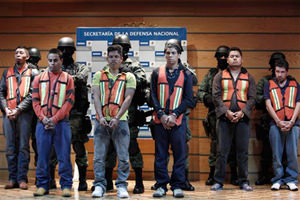
MATAMOROS, Mexico — Of all the iconography that one encounters when traversing the border regions between the United States and Mexico — a land informed by the exploits of Mexican and American bandits and smugglers and which was part of a single country until 1836 — two images stand out to a visitor.
Gazing out at passersby from clothing shops and discount stores on both sides of the border, the first is a visage of dapper, mustachioed solemnity: The face of Jesús Malverde. Often depicted today on T-shirts and baseball caps with marijuana leafs wreathing his face, Malverde was said to have been an outlaw from the northwestern Mexican state of Sinaloa. The main shrine dedicated to Malverde — allegedly executed by authorities in about 1909 and revered as a quasi-saint by many in Mexico’s criminal underworld — is in the Sinaloan city of Culiacan, birthplace of the eponymous Cartel de Sinaloa, headed by Joaquin “El Chapo” Guzman Loera, perhaps Mexico’s most famous drug trafficker.
The other image is that of a hooded, scythe-wielding skeleton, Santa Muerte (Saint Death). Like Jesús Malverde, Santa Muerte — whose main shrine in the rough-and-ready Mexican city barrio of Tepito sees visitors greeted by the skeletal lady in a white wedding dress — has become an object of veneration among Mexico’s criminals.
Here in Matamoros, a community of about 500,000 that gave birth to the criminal organization known as the Cartel del Golfo (Gulf Cartel) and which sits just across the Rio Grande from Brownsville, Texas, these figures, culled from the rich imagery of religion and crime, have now been joined by new depictions of transgression and loss.
At the Matamoros morgue, plastered to its glass doors amid a stench of human decay, the faces of dozens of people who have disappeared in this Mexican state of Tamaulipas over the last year gaze out onto the world. Relatives believe that they may be among the 183 bodies exhumed from 40 separate pits by Mexican authorities over the last month or so, likely victims of the Gulf Cartel’s erstwhile allies-turned-enemies, Los Zetas.
In the annals of a conflict that has killed more than 34,600 since Mexican President Felipe Calderon militarized his country’s battle against drug traffickers in December 2006, the conflict in Tamaulipas is writing a new and bloody chapter.
Cartel Recruited Elite Army Unit’s Members
What would grow into the present-day Cartel del Golfo had its genesis in Matamoros and the enterprising diversification of a Mexican smuggler and bootlegger named Juan Nepomuceno Guerra. Born in 1915, Guerra and his nephew, Juan Garcia Abrego, had decided by the 1970s to expand the criminal band’s connections with Colombia’s Cali Cartel, and had developed an extensive web of corruption of local, state and federal government officials in Tamaulipas.
Garcia Abrego was arrested at a ranch in the Mexican state of Nuevo Leon in January 1996 and subsequently sentenced to 11 life terms in the United States for drug trafficking. Guerra died in 2001 of natural causes. Control of the cartel fell into the hands of Osiel Cardenas Guillen, a former mechanic who promptly earned the sobriquet El Mata Amigos (Friend Killer) by dispatching a potential rival, a close personal acquaintance.
When Cardenas recruited as his lieutenants his two brothers — Antonio Ezequiel Cardenas Guillen (aka Tony Tormenta, or Tony the Storm) and Mario Cardenas Guillen — as well as Jorge Eduardo “El Coss” Costilla Sanchez, a former Matamoros police officer, the modern-day Gulf Cartel was born.
Feeling under pressure from his rivals after his ascension to the head of the cartel, in the late 1990s Cardenas began to recruit active members of an elite Mexican army unit, the Grupo Aeromovil de Fuerzas Especiales (GAFE), to become the organization’s military wing. Trained originally in counterinsurgency and counternarcotics tactics, the GAFE deserters were also skilled in such tactics as rapid deployment, intelligence collection, countersurveillance and ambush.
Initially led by Arturo Guzman Decena, known as Z1 (“Zeta” in Spanish) after a Mexican radio code for high-ranking officers. Guzman Decena was killed in November 2002, and his successor, Rogelio Gonzalez Pizaña (Z2), was scooped up by authorities less than two years later. The leadership of Los Zetas then coalesced around Heriberto Lazcano Lazcano (Z3), a man whose violence caused him to become known as El Verdugo (The Executioner).
For a time, the arrangement worked. Los Zetas proved themselves to be so adept at killing and terrorizing the cartel’s enemies that they were even recruited to train members of La Familia, Gulf Cartel allies based in the western state of Michoacan and at the time led by Nazario Moreno Gonzalez. Known as El Mas Loco (The Craziest One), Moreno invested La Familia with quasi-religious overtones, even giving the group’s foot soldiers a book of his aphorisms to carry along as they committed such acts as hurling five decapitated heads across the floor of the Sol y Sombra (Sun and Shadow) nightclub in September 2006. Moreno would be killed in a gun battle with Mexican security forces in December 2010.
La Familia was outrageous and bizarre, but it proved to be only the smallest foreshadowing of what was to come. Shortly after the Sol y Sombra incident, Felipe Calderon was elected Mexico’s president and declared war on the country’s drug trade. In an equally significant corollary, although hardly commented upon at the time, Osiel Cardenas Guillen, who had been running the Gulf Cartel from a Mexican prison cell since his arrest in March 2003, was extradited to the United States.
The glue that had held together one of Mexico’s most powerful drug trafficking operations for a decade was becoming unstuck. The center would not hold. Pits Filled With the Dead at San Fernando
Following the extradition of Cardenas, relations between the Gulf Cartel and the Zetas grew ever more strained. Members of the latter, high on their own sense of power and fortified by copious amounts of cocaine and Buchanan whisky (the cartel libation of choice), had little use for their former bosses, diminished as they were by the Cardenas arrest and a decentralized system that saw Cardenas’ brother Tony Tormenta and the former cop El Coss acting as co-heads of the organization.
The January 2010 slaying of Victor Mendoza, a Zeta lieutenant killed by a Gulf Cartel gunman in circumstances that are not entirely clear, proved to be the match that lit the bonfire of violence that now threatens to consume Tamaulipas.
Following pitched battles in the city of Reynosa, about 50 miles west of Matamoros, the Gulf Cartel claimed control of those two cities, with the Zetas ruling in the state capital, Ciudad Victoria, and in Nuevo Laredo, the Mexican counterpart of Laredo, Texas. The space between these population centers consists of little-patrolled rough countryside, and became the scene of the most ruthless kind of war as each side tried to eliminate the other.
“The current levels of violence are indeed changing the entire culture of the border region,” says Guadalupe Correa-Cabrera, a professor at the University of Texas at Brownsville who has studied the conflict extensively. “The levels of violence have escalated to unprecedented levels, and the new practices by killers are extreme and had never been observed in the past.”
Correa-Cabrera is referring to the 183 confirmed dead recovered thus far from the San Fernando pits, roughly 80 miles to the south, but her observations are anything but distant and academic. The university campus where she works, just across the Rio Grande from Matamoros, has been struck on three separate occasions by bullets fired during confrontations on the Mexican side.
Almost unbelievably, before this latest outrage, San Fernando, surrounded by rural roads and ranches, had been the scene of a similar mass killing less than a year earlier, when a group believed to be the Zetas killed 72 Central American migrants outside the town in August 2010 after holding them for ransom. Since the most recent killings, 16 local police officers have been detained under suspicion of involvement.
“They recruit boys from 13 to 17 years old,” says a 19-year-old university student from Matamoros, speaking in hushed tones about the cartels. “The police are also involved in this.”
Since the February 2010 mutiny by the Zetas, two loose and broad-based cartel alliances have seemed to coalesce. One configuration consists of the Gulf Cartel, the Sinaloa Cartel and the now greatly diminished La Familia; the Zetas have aligned themselves with the Cartel de Juarez (based in the eponymous city in the state of Chihuahua in western Mexico) and the Beltran-Leyva Carte, which became famous for its use of 12-year-old hit men and has suffered the loss of its top leaders through killings and imprisonment at the Calderon government’s hands. The Zetas have also reinforced themselves by recruiting members of Los Kabiles, a special-operations unit of the Guatemalan army trained in jungle warfare and counterinsurgency tactics and that had a particularly ghastly record in that country’s civil war.
In Tamaulipas, at least, the federal government has often seemed little more than a hapless referee as the two sides have battled each other for control of lucrative drug trafficking routes with ever-increasing levels of savagery. The dumping of dismembered bodies in the state has become almost routine, while gruesome videos of the foot soldiers of various factions being beheaded or otherwise killed are posted to websites such as the anonymously run Blog del Narco as a way to send messages and spread fear among opponents.
Though several midlevel Zeta operatives have been killed or captured, perhaps the Calderon government’s most notable victory in the region was the killing of Tony Tormenta during an hours-long gun battle in Matamoros last November. Although the official reports said that four cartel gunmen, three marines and a reporter perished during a series of gun battles throughout the city, Matamoros residents put the number of dead that day at closer to 100.
In February of this year, banners addressed to the Zetas were hung from bridges in Tamaulipas and three other Mexican states. They contained the claim, among others, that the state “had already witnessed the killing and massacre of innocent people by the Zetas” and a demand that the group “fight like men.” The banners were signed Carteles Unidos (United Cartels), an apparent reference to the Gulf-Sinaloa-La Familia alliance.
An entire new vocabulary of neologisms — from narcocorridos (songs) and narcomantas (banners) to narcobloqueos (blockades) — has taken root in Mexican culture as the society at large seeks ways to label the pervasive influence of drug traffickers and their signifiers.
“People are tired,” says Mauricio Meschoulam, a professor at the department of international studies at the Universidad Iberoamericana in the capital of Mexico City, where an estimated 150,000 people marched against the violence this month. “They feel that the government’s fight is unsuccessful and that the government is not in control of the situation. This perception increased sharply in 2010, especially in the second half of the year.”
Endless Violence Fueled by U.S. Firearms
Though the violence in Tamaulipas is shocking, it is not isolated.
In Ciudad Juarez, a Mexican city of 1.3 million people across the Rio Grande from El Paso, Texas, 3,000 people were killed last year during a power struggle between the Cartel de Juarez and the Cartel de Sinaloa and a general breakdown in law and order not lessened by the presence of the Mexican army. This past February, Jaime Zapata, a U.S. Immigration and Customs Enforcement agent, was shot to death and his partner was wounded as they drove in the Mexican state of San Luis Potosi. A known member of Los Zetas was subsequently arrested for his killing.
On May 19, a gun battle between suspected Zetas and Mexican marines patrolling Falcon Lake, which sits on the border between Texas and Tamaulipas, left 12 gang members and one marine dead. Last September, U.S. boater David Hartley disappeared after being chased and shot by gunmen on the Mexican side of the lake’s border. The severed head of the Mexican police commander in charge of investigating the case was subsequently left outside a Mexican army post.
The policies of the United States, involved in a perversely symbiotic relationship with Mexico in which drugs flow north and weapons flow south, have not been helpful.
A recent report by the United Nations Office on Drugs and Crime concluded that the U.S., with a population of 310 million, consumed $37 billion in cocaine in 2008, while Europe as a whole, with a population of 830 million, consumed $34 billion. Over the past four years, as The Washington Post has reported, more than 60,000 U.S. guns have been found in Mexico, largely coming from gun dealers in states with conspicuously liberal gun laws such as Texas and Arizona. The AK-47 used to kill agent Jaime Zapata was traced to a legal purchase at a Texas gun store.
In the meantime, the brazen and highly ritualized drumbeat of violence continues, leading observers on both sides of the border to wonder just how deeply it is permanently changing Mexico.
“How can you justify these extreme new practices and massacres?” asks professor Correa-Cabrera. “How can someone justify to himself assassinating dozens of men, women and children?”
“The economic explanation is definitely an important one,” she continues. “But there must be more elements in these new and extreme forms of violence. A new culture and new beliefs are taking hold.”
Your support matters…Independent journalism is under threat and overshadowed by heavily funded mainstream media.
You can help level the playing field. Become a member.
Your tax-deductible contribution keeps us digging beneath the headlines to give you thought-provoking, investigative reporting and analysis that unearths what's really happening- without compromise.
Give today to support our courageous, independent journalists.

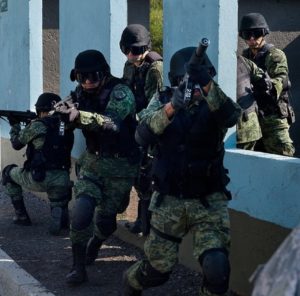
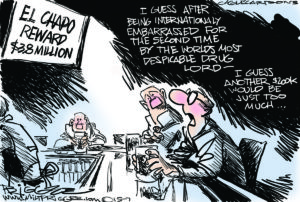
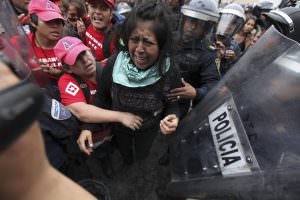

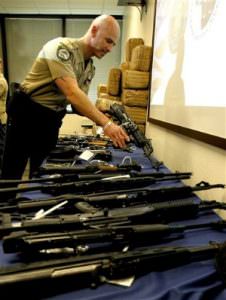
You need to be a supporter to comment.
There are currently no responses to this article.
Be the first to respond.